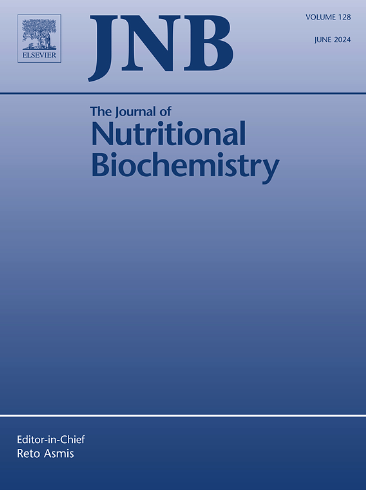从淡水甲壳类动物中获得的虾青素通过调节脂肪组织脂肪生成和改善高糖饮食喂养大鼠的血脂异常来减轻内脏脂肪
IF 4.9
2区 医学
Q1 BIOCHEMISTRY & MOLECULAR BIOLOGY
引用次数: 0
摘要
世界各地超重和肥胖的发病率继续以惊人的速度增长。寻找对预防/治疗超重/肥胖及相关疾病有潜在益处的食物具有重要意义。本研究的目的是评估淡水甲壳类动物(螃蟹)虾青素(ASTX)对代谢综合征啮齿动物模型中内脏脂肪、脂肪组织脂质代谢紊乱和血脂异常的影响。雄性Wistar大鼠分别饲喂4种试验饲料中的1种,饲养90 d: a-参照组(RD)饲喂标准鼠粮,b-高糖饲料(HSD)组饲喂高糖饲料(HSD), c- RD+ASTX组饲喂标准鼠粮+ASTX, d- HSD+ASTX组饲喂HSD+ASTX。大鼠分别口服ASTX(葵花籽油中添加10 mg/kg体重/天)或只口服葵花籽油。与饲喂HSD的大鼠相比,HSD+ASTX组的体重增加(19%)较低,腹围(5%)和内脏脂肪指数(5%)均减小。试验中期能量摄入量降低24%。附睾脂肪细胞大小和甘油三酯(TG)含量降低14%。附睾脂肪组织脂肪酸合成酶、苹果酸酶和葡萄糖-6-磷酸脱氢酶活性分别降低43%、28%和38%。这些变化伴随着TG(25%)和胆固醇(27%)血清水平降低,动脉粥样硬化指数(31%)降低,收缩压(12%)和舒张压(15%)降低。结果表明,ASTX可能是预防/减轻代谢危险因素(如超重/肥胖和血脂异常)发生率的潜在策略。本文章由计算机程序翻译,如有差异,请以英文原文为准。

Astaxanthin obtained from freshwater crustaceans mitigates visceral adiposity by modulating adipose tissue lipogenesis and ameliorates dyslipidemia in high-sucrose diet fed rats
The incidence of overweight and obesity continues to grow at alarming rates around the world. The search for foods with potential benefits in the prevention/treatment of overweight/obesity and related disorders has great relevance. The aim of this study was to evaluate the effect of astaxanthin (ASTX) from freshwater crustaceans (crabs) upon visceral adiposity, adipose tissue lipid metabolism disorders and dyslipidemia present in a Metabolic Syndrome rodent model. Male Wistar rats were fed for 90 days with 1 of 4 experimental diets: a-Reference group (RD) received a standard commercial rodent diet, b- High-sucrose diet (HSD) group received a HSD, c- RD+ASTX group received a standard commercial rodent diet plus ASTX, d- HSD+ASTX group received a HSD plus ASTX. The rats were given orally either ASTX (10 mg/kg body weight/day in sunflower oil) or only sunflower oil. Compared with HSD-fed rats, HSD+ASTX group had lower body weight gain (19%) and both reduced abdominal circumference (5%) and visceral adiposity index (5%). Energy intake was 24% lower at the middle of the experimental period. Epididymal adipocytes size and triglyceride (TG) content was reduced by 14%. Besides, fatty acid synthase, malic enzyme and glucose-6-phosphate dehydrogenase activities in epididymal adipose tissue were 43%, 28% and 38% lower respectively. These changes were accompanied by lower TG (25%) and cholesterol (27%) serum levels, atherogenic index (31%) and reduced Systolic (12%) and Diastolic (15%) blood pressure. The results show that ASTX could be a potential strategy to prevent/attenuate the incidence of metabolic risk factors such as overweight/adiposity and dyslipidemia.
求助全文
通过发布文献求助,成功后即可免费获取论文全文。
去求助
来源期刊

Journal of Nutritional Biochemistry
医学-生化与分子生物学
CiteScore
9.50
自引率
3.60%
发文量
237
审稿时长
68 days
期刊介绍:
Devoted to advancements in nutritional sciences, The Journal of Nutritional Biochemistry presents experimental nutrition research as it relates to: biochemistry, molecular biology, toxicology, or physiology.
Rigorous reviews by an international editorial board of distinguished scientists ensure publication of the most current and key research being conducted in nutrition at the cellular, animal and human level. In addition to its monthly features of critical reviews and research articles, The Journal of Nutritional Biochemistry also periodically publishes emerging issues, experimental methods, and other types of articles.
 求助内容:
求助内容: 应助结果提醒方式:
应助结果提醒方式:


